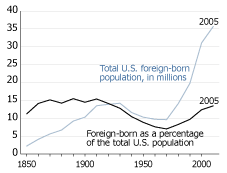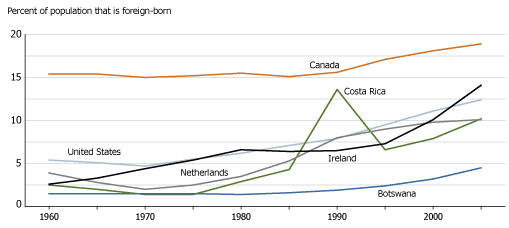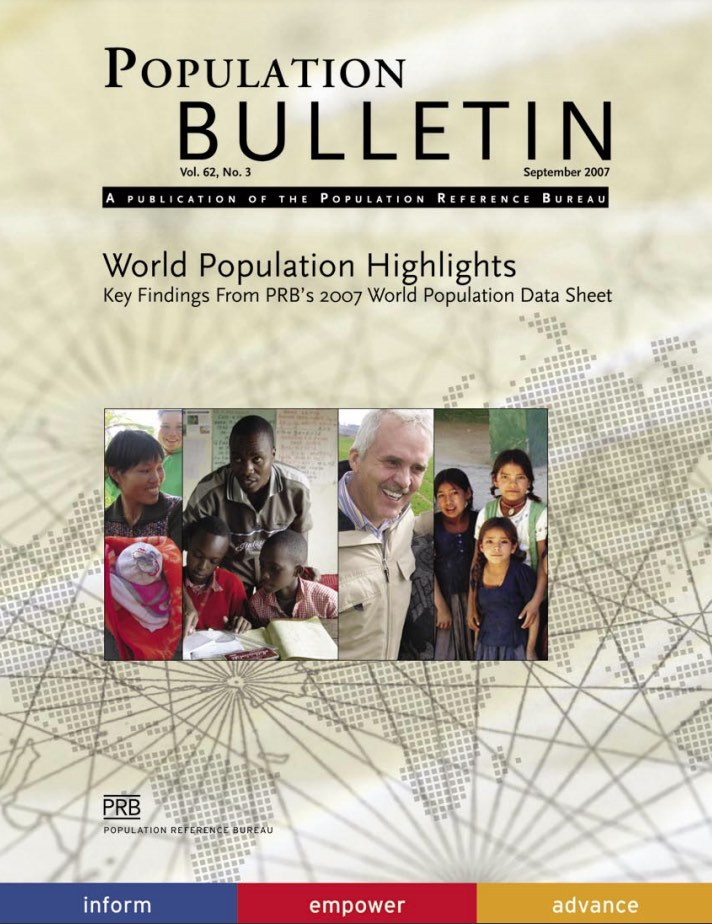
World Population Highlights 2007: Migration
Date
August 16, 2007
Author
Focus Area
(September 2007) In 2005, about 191 million people—3 percent of the world’s population—were international migrants, according to UN estimates. Migration continues to be an important determinant of the size and characteristics of populations in some countries and especially in certain areas within countries.
Between 1995 and 2000, around 2.6 million migrants per year moved from less developed to more developed regions. More than one-half of these settled in the United States and Canada.
About 40 percent of international migrants move from one less developed country to another: from Paraguay to Brazil, or from Ghana to Côte d’Ivoire, for example. In Southeast Asia, migrants from Cambodia, Indonesia, and Myanmar seek jobs in Singapore, Thailand, South Korea, and other newly industrialized countries in Asia.
U.S. Immigration
Immigration has a major effect on the size, distribution, and composition of the U.S. population, and its role has increased because national birth and death rates are relatively low. Immigration contributed at least a third to the total population increase between 1990 and 2000, as the number of foreign-born U.S. residents rose from almost 20 million to over 31 million.
The number of foreign-born persons (the first generation) is projected to rise from 31 million in 2000 to 48 million in 2025, and the foreign-born share of the U.S. population is projected to increase from 11 percent to about 14 percent. Accordingly, the number of second-generation Americans—the children of immigrants—will continue to increase.
In 2000, first- and second-generation Americans were about 21 percent of the U.S. population. If net legal and illegal immigration averages just 820,000 per year, first- and second-generation Americans are projected to be about one-third of the U.S. population in 2025.
Immigrants are an important part of the increase in the labor force because they tend to be of working age. Immigrants accounted for nearly 50 percent of the total labor force increase between 1996 and 2000, and as much as 60 percent of the increase between 2000 and 2004. Assuming net immigration of about 1 million per year, new immigrants and their children will account for all of the growth in the U.S. labor force between 2010 and 2030.
Foreign-Born Residents of the U.S. Make Up a Smaller Share of the Total Population Than in 1910, but Their Numbers Have Never Been Higher.

Source: U.S. Census Bureau.
Refugees
The number of refugees worldwide, defined by the United Nations as “people who have fled persecution in their own countries to seek safety in neighboring states,” rose from 8.7 million to 9.9 million during 2006. The rise in the refugee population in 2006 was due in large part to the displacement of Iraqis to other countries, particularly to Syria and Jordan.
An increasing number of people—more than 24.5 million—are “internally displaced,” forcibly relocated within their own countries by violent conflict or environmental disasters. This figure includes substantial numbers of people in Iraq, Sudan, and Colombia.
But these populations don’t receive the attention or services accorded refugees who leave their countries because of persecution. International law mandates that refugees receive food, shelter, and safety in their host countries as well as international support. The internally displaced—who have few legal or physical protections—face a less certain fate. Unlike refugees, internally displaced persons have had no single UN organization with an express mandate to help and shield them.
South-South Migration
In coming decades, more migration will occur between developing countries, such as that from Bangladesh to India, or from India, Egypt, and Yemen to the Persian Gulf States.
By one preliminary estimate, 74 million (nearly one-half) of the migrants from developing countries reside in other developing countries. Almost 80 percent of migration from one developing nation to another takes place between countries with contiguous borders. Most appears to occur between countries with relatively small differences in income.
Foreign-Born Populations Are Rising In Both Industrialized and Developing Countries.

Source: United Nations and U.S. Census Bureau.
Feminization of Migration
Data collected by governments indicate that women account for almost half of immigrants around the world. Women now are increasingly likely to move for economic opportunity, rather than to join husbands or other family members as they did in the past. Despite women’s growing independence, the so-called “feminization of migration” raises policy concerns about women’s security and human rights in sending and destination countries.
The proportion of female migrants is higher in countries that long have been open to immigration, including the United States, Canada, and Australia. For example, 55 percent of recent legal immigrants to the United States are women. In countries that permit only temporary migration, the proportion of men may be higher, particularly if admission is limited to occupations typically dominated by men.
Sending countries also differ in the percent of women and men who emigrate, in part because of differential demand for labor in destination countries. For example, 70 percent of all Filipino labor migrants are women.
Case In Point.
Migration to, from, and within the Middle East and North Africa is augmenting, diminishing, or reshaping the populations of many of its countries.
In some oil-rich Persian Gulf states, foreigners have become a majority of the labor force, filling service and skilled jobs that native-born workers could not or would not take. In Bahrain, for example, 47 percent of workers are foreign-born men, 11 percent foreign-born women. In Kuwait, 64 percent are foreign-born men, 17 percent foreign-born women. Foreigners make up half the labor force in Saudi Arabia.
These immigrants send home billions of dollars in remittances to help their families. But they often work long hours and have limited ability to challenge their employers for failing to deliver on promised pay and benefits.
In other parts of the region, people are leaving to seek economic opportunities or escape violence or political instability. In North Africa, a region of emigration, foreigners make up less than 1 percent of the population. In 2004, one-third of France’s 3.3 million foreigners were from Morocco, Algeria, Turkey, and Tunisia. One-third of Germany’s 6.9 million foreign-born population was from the Middle East and North Africa.
Sources
Carl Haub, 2007 World Population Data Sheet (Washington, DC: Population Reference Bureau, 2007).
Farzaneh Roudi-Fahimi and Mary M. Kent, “Challenges and Opportunities—The Population of the Middle East and North Africa,” Population Bulletin 62, no. 2 (2007).
Mary M. Kent and Carl Haub, “Global Demographic Divide,” Population Bulletin 60, no. 4 (2006).
Philip Martin and Elizabeth Midgley, “Immigration: Shaping and Reshaping America,” Population Bulletin 61, no. 4 (2006).
Philip Martin and Elizabeth Midgley, “International Migration,” Population Bulletin (forthcoming).
Dilip Ratha and William Shaw, “South-South Migration and Remittances,” accessed online at www.worldbank.org, on July 2, 2007.
UN High Commissioner for Refugees (UNHCR), 2006 Global Trends (Geneva: UNHCR, 2007).
Sandra Yin, “The Plight of Internally Displaced Persons,” accessed online at www.prb.org, on July 2, 2007.
Nancy V. Yinger, “Feminization of Migration,” accessed online at www.prb.org, on July 2, 2007 .

 ">
">